That could still leave the guy behind the 'scope floating at 110v.
Not a situation I'd put a neophyte in.
The first rule of working on line-powered switchers, is to run it on a reliable isolation transformer.
As there might still be leakage, I use two robust 24v transformers, back to back.
I'm all for giving tricks to the newbies, but not if it might kill a stupid one.
And when it comes to strangers on a forum, ya just can't tell.
edit:
Oh, you might be right!
And that makes my point!
Anole,
You are definitely correct. I also use an isolation transformer, but failed to mention so. The iso transformer I have is a manufactured one that I got from work as salvage. I use the 3-prong to 2-prong adapter plug on its cord to ensure that earth ground isn't tied in there somewhere. I should have been more specific.
EDIT: May I add that I also did not expect Fhorta to rush right out and buy an O'scope for this task nor did I expect that he already owned one. Therefore the situation is moot other than the learning that was gained by all. I don't wish to withold information, but I don't want to sacrifice anyone's personal safety either. I know that you believe me in this regard, but I should have explained it in detail right off.
RADAR
Last edited:


